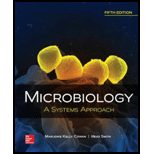
Microbiology: A Systems Approach
5th Edition
ISBN: 9781259706615
Author: Marjorie Kelly Cowan Professor
Publisher: McGraw-Hill Education
expand_more
expand_more
format_list_bulleted
Concept explainers
Question
Chapter 4, Problem 1CM
Summary Introduction
To create:
A concept map illustrating the relationships among key terms such as genus, species, serotype, domain, Borrelia burgdorferi and spirochete.
Concept introduction:
The most common type of the prokaryotes is bacteria. They are found in every existing environment on the earth and although they are small in size, their biomass exceeds of animals and plants combined. The cell wall of bacteria is made up of peptidoglycan layer, they lack membrane-bound organelles and exhibit an asexual mode of reproduction.
Expert Solution & Answer
Want to see the full answer?
Check out a sample textbook solution
Students have asked these similar questions
Please draw in the missing answer, thank you
Please fill in all blank questions, Thank you
please fill in missing parts , thank you
Chapter 4 Solutions
Microbiology: A Systems Approach
Ch. 4.1 - List the structures all bacteria possess.Ch. 4.1 - Identify at least four structures that some, but...Ch. 4.1 - Prob. 3AYPCh. 4.1 - Prob. 4AYPCh. 4.1 - Provide at least four terms to describe bacterial...Ch. 4.2 - Describe the structure and function of five...Ch. 4.2 - Prob. 7AYPCh. 4.3 - Prob. 8AYPCh. 4.3 - Prob. 9AYPCh. 4.3 - Prob. 10AYP
Ch. 4.4 - Prob. 11AYPCh. 4.4 - Prob. 12AYPCh. 4.5 - List some differences between archaea and...Ch. 4.6 - Differentiate between Bergeys Manual of Systematic...Ch. 4.6 - Prob. 15AYPCh. 4.6 - Define a species in terms of bacteria.Ch. 4 - Which of the following is not found in all...Ch. 4 - Pili are tubular shafts in ____ bacteria that...Ch. 4 - Prob. 3MCQCh. 4 - Which of the following is a primary bacterial cell...Ch. 4 - Which of the following is present in both...Ch. 4 - Darkly stained granules are concentrated crystals...Ch. 4 - Bacterial endospores usually function in a....Ch. 4 - A bacterial arrangement in packets of eight cells...Ch. 4 - Prob. 9MCQCh. 4 - Prob. 10MCQCh. 4 - Prob. 11TFCh. 4 - A research microbiologist looking at evolutionary...Ch. 4 - Nanobes may or may not actually be bacteria.Ch. 4 - Both bacteria and archaea used to be known as...Ch. 4 - Prob. 15TFCh. 4 - Define the term ubiquitous and explain whether...Ch. 4 - Quorum sensing is a process used by many bacteria...Ch. 4 - Based upon your knowledge of cell wall structure,...Ch. 4 - Provide evidence in support of or refuting the...Ch. 4 - a.Describe the characteristics of an...Ch. 4 - Prob. 1VCCh. 4 - From chapter 1, figure 1.14. Study this figure....Ch. 4 - Prob. 1CM
Knowledge Booster
Learn more about
Need a deep-dive on the concept behind this application? Look no further. Learn more about this topic, biology and related others by exploring similar questions and additional content below.Similar questions
- please draw in the answers, thank youarrow_forwarda. On this first grid, assume that the DNA and RNA templates are read left to right. DNA DNA mRNA codon tRNA anticodon polypeptide _strand strand C с A T G A U G C A TRP b. Now do this AGAIN assuming that the DNA and RNA templates are read right to left. DNA DNA strand strand C mRNA codon tRNA anticodon polypeptide 0 A T G A U G с A TRParrow_forwardplease answer all question below with the following answer choice, thank you!arrow_forward
- please draw in the answeres, thank youarrow_forwardA) What is being shown here?B) What is indicated by the RED arrow?C) What is indicated by the BLUE arrow?arrow_forwardPlease identify the curve shown below. What does this curve represent? Please identify A, B, C, D, and E (the orange oval). What is occurring in these regions?arrow_forward
- Please identify the test shown here. 1) What is the test? 2) What does the test indicate? How is it performed? What is CX? 3) Why might the test be performed in a clinical setting? GEN CZ CX CPZ PTZ CACarrow_forwardDetermine how much ATP would a cell produce when using fermentation of a 50 mM glucose solution?arrow_forwardDetermine how much ATP would a cell produce when using aerobic respiration of a 7 mM glucose solution?arrow_forward
- Determine how much ATP would a cell produce when using aerobic respiration to degrade one small protein molecule into 12 molecules of malic acid, how many ATP would that cell make? Malic acid is an intermediate in the Krebs cycle. Assume there is no other carbon source and no acetyl-CoA.arrow_forwardIdentify each of the major endocrine glandsarrow_forwardCome up with a few questions and answers for umbrella species, keystone species, redunant species, and aquatic keystone speciesarrow_forward
arrow_back_ios
SEE MORE QUESTIONS
arrow_forward_ios
Recommended textbooks for you
 Biology Today and Tomorrow without Physiology (Mi...BiologyISBN:9781305117396Author:Cecie Starr, Christine Evers, Lisa StarrPublisher:Cengage Learning
Biology Today and Tomorrow without Physiology (Mi...BiologyISBN:9781305117396Author:Cecie Starr, Christine Evers, Lisa StarrPublisher:Cengage Learning Biology 2eBiologyISBN:9781947172517Author:Matthew Douglas, Jung Choi, Mary Ann ClarkPublisher:OpenStax
Biology 2eBiologyISBN:9781947172517Author:Matthew Douglas, Jung Choi, Mary Ann ClarkPublisher:OpenStax Medical Terminology for Health Professions, Spira...Health & NutritionISBN:9781305634350Author:Ann Ehrlich, Carol L. Schroeder, Laura Ehrlich, Katrina A. SchroederPublisher:Cengage LearningEssentials Health Info Management Principles/Prac...Health & NutritionISBN:9780357191651Author:BowiePublisher:Cengage
Medical Terminology for Health Professions, Spira...Health & NutritionISBN:9781305634350Author:Ann Ehrlich, Carol L. Schroeder, Laura Ehrlich, Katrina A. SchroederPublisher:Cengage LearningEssentials Health Info Management Principles/Prac...Health & NutritionISBN:9780357191651Author:BowiePublisher:Cengage


Biology Today and Tomorrow without Physiology (Mi...
Biology
ISBN:9781305117396
Author:Cecie Starr, Christine Evers, Lisa Starr
Publisher:Cengage Learning

Biology 2e
Biology
ISBN:9781947172517
Author:Matthew Douglas, Jung Choi, Mary Ann Clark
Publisher:OpenStax


Medical Terminology for Health Professions, Spira...
Health & Nutrition
ISBN:9781305634350
Author:Ann Ehrlich, Carol L. Schroeder, Laura Ehrlich, Katrina A. Schroeder
Publisher:Cengage Learning

Essentials Health Info Management Principles/Prac...
Health & Nutrition
ISBN:9780357191651
Author:Bowie
Publisher:Cengage
Fossil: The Language & History of Paleontology; Author: Alliterative;https://www.youtube.com/watch?v=x9yNwRBlKtU;License: Standard youtube license